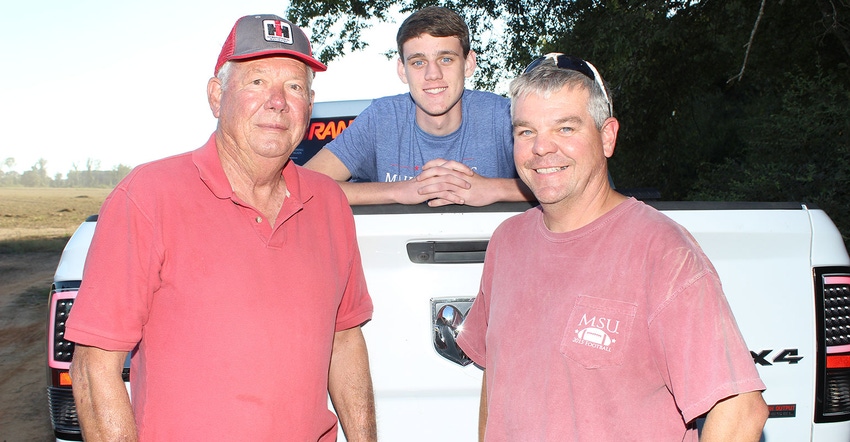
Dr. Alan Henn, plant pathologist with the Mississippi State University Extension Service, and Alan Atkins, Atkins Farms, near Hamilton, Miss., have a mutually-beneficial partnership in peanuts. Atkins grew a little over 800 acres of the Georgia 06G variety in 2018, and Henn conducts peanut research on a few of Atkins Farm’s 2,500 acres.
When low prices drove Atkins out of cotton in 2006, peanuts seemed like a logical crop choice agronomically for the sandy soils they had in their rolling hill region of the state. It turned out to be an excellent choice logistically when Birdsong Peanuts set up a buying point just down the road in Prairie, Miss., in 2008. They trucked their peanuts to Goshen, Ala., the first two years. “We tried cotton again in 2011, but it just didn’t work for us, so we sold our equipment,” explains Atkins. “It was about that time I met Dr. Henn. He is one of the hardest working Extension guys I’ve ever seen in my life.”
The Atkinses are a four generational farming family. The youngest is Jamie Dean, Alan Atkins’ son, who is about to start college. The oldest is Jamie’s grandfather, William Dean (WD to those that know him) who, at 77, stills sets a frenetic farming pace.
“I was eight years old when granddad had a heart attack,” remembers Jamie Atkins. “I had riden in our tractors with my dad and granddad growing up, but after his heart attack, I was given a few specific instructions and then was drafted into the farm family labor pool!”
Jamie Dean has carved a notche or two in the sides of a few peanut trailers and dented the plate on the back of the do-all, but it gave WD and Alan a perfect teaching moment. “They weren’t mad at me, but they sure let me know how to avoid it in the future,” says Jamie with a wry smile.
Today the family farms wheat, corn, soybeans and peanuts. Because of seemingly never ending rounds of spring rain, they only got 60 acres of corn in the ground last year — well short of their normal 700 acres. They swapped over to soybeans, but the increased soybean acreage put them behind the harvest eight ball because they had to get peanuts out first. “We basically had one-third of our ground in peanuts and two-thirds in soybeans,” says Alan Atkins. “We didn’t cut our last soybeans until the first week of December.”
Learning Peanuts
Runner peanut varieties that are common across the Southeast were bred in north Florida, south Georgia, or south Alabama. “That’s where the peanut breeders are located, and they don’t breed with a concern about the length of a growing season,” explains Henn. “Once you get north of Mississippi Highway 82, the length of the growing season for peanuts shortens and those long-season varieties really hurt growers in our area.”
If early rains delay planting or late-season rains move in when peanuts need to be dug up and turned over to dry, the Atkinses always face the increased possiblilty of cold weather and potential damage to their crop from frost.
When Henn started working in peanuts in 2011, Atkins was gracious enough to let him set up a 3-acre research nursery. “I’ve been conducting some trials with a few shorter season varieties from Texas, but it’s dry out west and they just don’t have the disease and pest pressure that we face here in this part of Mississippi,” adds Henn. “When we brought those varieties here, they just got eaten up by foliar diseases and soilborne diseases, especially Southern blight, also known as stem rot.”
There are a few other major leaf spot diseases and several smaller, less prevalent diseases Henn is also analyzing on his Atkins Farms research plots. The Atkins family usually starts planting peanuts around the last week in April, which makes harvest, hopefully, around Sept. 20
Atkins had a few leaf blight hot spots in his peanuts last year, but he says it has been much worse in past years. “I attribute the low pest pressure last year to the really cold winter we had,” remembers Atkins.
Henn is attempting to determine the optimum time to initiate control measures for leaf blight and stem rot, and which fungicides or other products offer the best control. One specific area on Atkins Farms usually has an especially heavy infestation of the pathogen. Henn is trying to determine why. “We are most definitely benefiting from Dr. Henn’s research efforts,” says Atkins. “Through his work, we’re using shorter season varieties and he is always open with his insight and his latest research.”
Cotton possible
The Atkins family farms fields from Caledonia, Miss., all the way to Prairie, Miss. Some of those fields may fall back into cotton this year. “We’ll have to see how the market looks on that,” says Alan Atkins.
Jamie will soon start his freshman year at Itawamba Community College. After two years, he plans to transfer to Mississippi State University and pursue a degree in agronomy. “After I graduate, I plan to come right back here and start farming with my dad and granddad,” says Jamie Atkins. “It’s really all I’ve ever wanted to do other than play baseball.”
The young Atkins is unsure if he will try out for Mississippi State’s baseball team, but he is sure he wants to make farming his career once he leaves college. “We are in a good spot for peanuts and soybeans, so I’ll be able to apply what I learn in college to our farm, be more valuable to my dad and granddad, and hopefully move our family farm into the next generation one day,” concludes Jamie Dean Atkins.
About the Author(s)
You May Also Like




